An Evening Walk Through the Heart of a Densely Packed Residential District: A Niji-Style Experience
April 7, 2025 | by alwaled
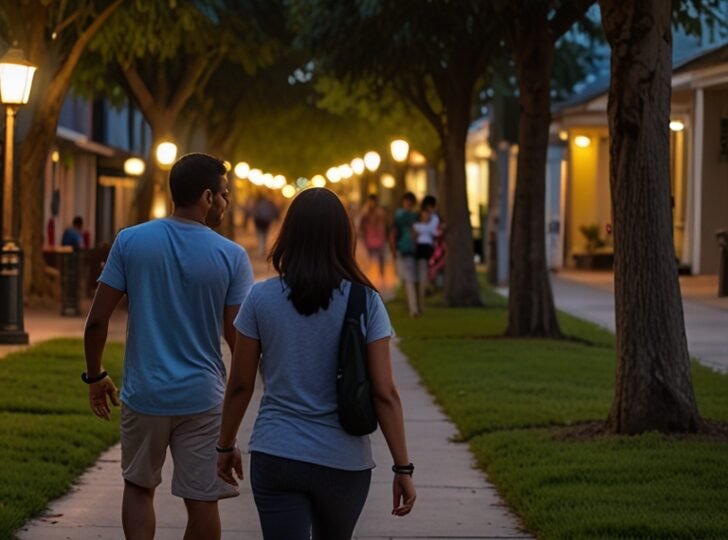
Introduction to the Evening Walk
As the sun dips below the horizon, the vibrant pulse of a densely packed residential district begins to emerge. An evening walk in such neighborhoods affords a unique opportunity to experience the charm and appeal of a community that thrives on diversity and connection. These strolls become a delightful adventure as the atmosphere transforms from the hustle and bustle of the day to a more serene ambiance in the twilight hours.
Engaging in an evening walk not only provides a chance to unwind after a long day but also promotes a healthy lifestyle through light exercise. The gentle rhythm of walking serves to release stress while encouraging mindfulness, allowing individuals to appreciate their surroundings in a way that often goes unnoticed during the rush of daily life. The simple act of walking can be a profound experience, enabling a deeper connection with one’s environment, neighbors, and self.


Moreover, an evening stroll invites exploration through the labyrinthine streets, showcasing the architectural and cultural diversity of the area. Each block presents a new tableau—children playing in courtyards, the aroma of home-cooked meals wafting from open windows, and the lively sounds of conversations punctuating the air. The sensory experiences encountered on these walks become a symphony of life, highlighting the stories woven into each home and sidewalk.
Such walks encourage interaction, fostering a sense of community among residents. In this densely populated setting, every passerby holds the potential for connection, whether it be a friendly nod, a wave, or a brief conversation. This shared engagement contributes to a feeling of belonging within a vibrant tapestry of urban life. Thus, the evening walk not only serves personal well-being but also enhances communal bonds, drawing attention to the beauty of shared experiences. As you embark on this journey, let the sights, sounds, and sensations shape your understanding of life within this lively district.


The Vibrant Atmosphere of a Densely Packed Neighborhood
As the sun begins to set, the unique atmosphere of a densely packed residential district transforms into a bustling hub of activity and vibrancy. The air is infused with the scents of dinner preparations wafting from open windows, combining with the savory fragrances of local street food vendors. Families gather on their balconies, sharing laughter and conversation, while children play in the remnants of daylight, their cheerful voices echoing through the narrow streets.
The sounds of this lively neighborhood evoke a sense of community. The distant hum of city traffic is punctuated by the cheerful chatter of neighbors exchanging greetings. Alongside these familiar sounds, one can hear the gentle laughter of children, the clinking of glasses from nearby cafés, and the soft music of buskers serenading passersby. Each element contributes to a unique auditory tapestry that characterizes evenings in such areas.


Walking through these closely-knit streets during the evening offers a multisensory experience. The ambient light casts a warm glow, illuminating vibrant murals and charming storefronts that line the roads. Decorative string lights crisscross above, creating an inviting environment that encourages residents and visitors alike to linger. The density of this neighborhood not only enhances the array of sights and sounds but also fosters a strong sense of togetherness among its inhabitants. Gathering in public spaces, residents unite to celebrate their cultural diversity and create shared memories.
This vibrant atmosphere serves as an invitation to explore the unique character of each residential block. The evening stroll becomes something more than just a walk; it is an opportunity to engage with fellow community members, embrace the dynamic essence of urban living, and appreciate the beauty that arises from creative coexistence. When enjoyed collectively, the evening becomes a canvas painted with the colors of life in the heart of a densely packed neighborhood.

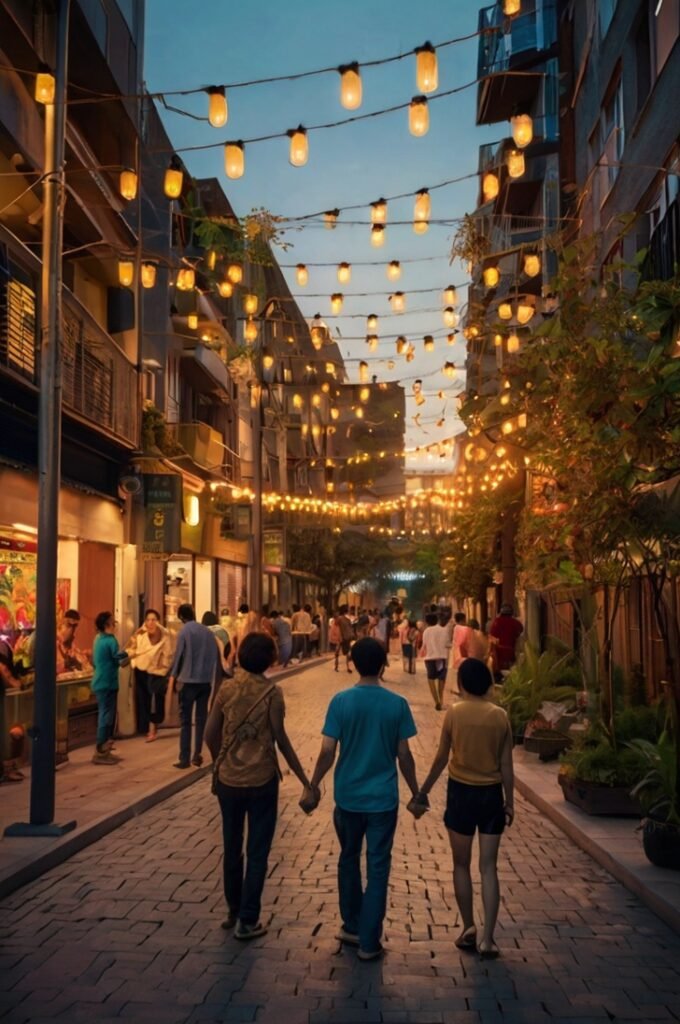


Observing Daily Life: A Cultural Perspective
As the sun sets and casts a warm glow over the densely packed residential district, the sounds of daily life emerge, painting a vivid picture of the community’s cultural tapestry. Walking through the streets during the evening reveals a dynamic interplay of local customs and traditions that shape the identities of the families residing here. Observations indicate that social interactions are intrinsic to the fabric of living in such close quarters.
Residents often gather in small groups outside their homes, exchanging greetings and discussing the events of the day. This communal interaction fosters a sense of belonging, reinforcing relationships that are vital in densely populated areas. Children, seen playing together on the sidewalks, highlight the significance of community in nurturing friendships and learning social dynamics from an early age. Their laughter resonates, suggesting that play is a cherished part of daily life and cultural enrichment.


The evening strolls showcase a variety of culinary delights being prepared in open kitchens. The aroma of diverse cuisines wafts through the air, illustrating how food acts as a cornerstone of cultural expression. Local markets remain bustling hubs even during the twilight hours, where families engage in the ritual of shopping for fresh ingredients. Here, one can witness practices such as sharing recipes and food recommendations, which demonstrate the importance of culinary heritage within the community.
Additionally, the architecture of the houses, with individual touches reflecting the residents’ backgrounds, tells a story of cultural diversity. Each dwelling serves as a canvas, revealing the identities and traditions of its inhabitants. Overall, it is evident that as one traverses the evening streets, the interactions, routines, and customs converge to portray a rich cultural experience that thrives in communal living.



Niji-Style: The Uniqueness of Colors and Light
Niji-style, derived from the Japanese word for “rainbow,” encapsulates a vibrant aesthetic that thrives in the interplay of color and light. This artistic approach is especially significant during evening walks within a densely packed residential district, where the atmosphere transforms as daylight recedes. The transition from natural sunlight to artificial street lighting manifests in a captivating spectrum, evoking the essence of a rainbow—a key aspect of the Niji-style experience.
As the sun begins its descent, hues of orange, pink, and purple merge across the sky, creating a mesmerizing backdrop. This sunset palette is complemented by the strategic placement of streetlights and illuminated signs, which together weave various shades of white, yellow, and even blue into the urban tapestry. The combined effect of these colors creates a visual symphony that invites onlookers to pause and appreciate their surroundings. A leisurely stroll during this hour reveals a unique characteristic of Niji-style; it encourages individuals to engage deeply with their environment, fostering mindfulness and a sense of presence in the moment.




Moreover, the experience transcends mere observation. Observers often find themselves reflecting on the beauty surrounding them, igniting a profound sense of gratitude and connection to the world. This synchronization of colors and light not only enhances the evening walk but also creates a soothing ambiance, alleviating the stresses of daily life. In this manner, the Niji-style experience becomes more than just a visual spectacle; it serves as a catalyst for introspection and emotional well-being.
Ultimately, the unique integration of colors and lights typically associated with Niji-style transforms a simple evening stroll into an enriching journey through the heart of a residential district, where each moment is painted with the gentle hues of reflection and tranquility.




The Role of Nature amid Urban Density
Amidst the tightly packed residential districts, where buildings often rise to the sky and streets bustle with activity, the presence of nature provides a vital counterbalance. Parks, trees, and gardens emerge as essential elements within these urban landscapes, facilitating a harmonious coexistence between human architecture and the natural world. The juxtaposition of concrete structures and verdant spaces serves to enrich the evening walk experience, offering moments of tranquility that are otherwise scarce in densely populated settings.
The integration of green spaces in residential areas has been recognized for its multiple benefits. Parks serve not merely as areas for leisure and recreation but also as ecosystems that enhance biodiversity. They act as essential urban lungs, purifying the air and providing habitats for various wildlife. Even in regions dominated by high-rises and commercial buildings, well-planned parks and communal gardens provide a necessary refuge for residents seeking solace from their bustling surroundings. The sight of lush trees swaying gently in the breeze, coupled with the sound of rustling leaves, fosters a sense of peace that is often missing in the city’s clamor.




Moreover, the presence of nature in these densely populated areas encourages a community-oriented environment. Local gardens become gathering places where residents engage with one another, fostering social interactions that strengthen neighborhood ties. Evening walks through these urban oases not only allow individuals to immerse themselves in the refreshing scents of flowers and foliage but also unite people by providing shared spaces for relaxation and reflection.
As such, the role of nature amid urban density is indispensable. It transforms mundane residential districts into vibrant living spaces that cater to both the needs of the community and the environment. By incorporating greenery into these areas, cities can enhance the quality of life for residents, creating a perfect balance between urban hustle and the tranquility nature provides.



People You Meet: Stories of the Neighborhood
As one embarks on an evening walk through a densely packed residential district, the encounters with various individuals become an intrinsic part of the experience. Families often take center stage, with parents guiding their children through neighborhood parks or engaging in playful banter as they stroll along the sidewalks. Such scenes evoke a sense of community, with parents witnessing the children’s first steps or sharing laughter over a friendly game of tag. These interactions remind us of the shared values that bind families together, highlighting the warmth often found in close-knit areas.
In addition to families, one may also cross paths with solitary joggers, each person with their own unique story. A jogger, for instance, may be found using this time to reflect on their day, seeking solace in the rhythmic pounding of their feet against the pavement. The act of running can serve as both a personal retreat and a means of connecting with the broader neighborhood. A simple exchange of a smile or a nod with a fellow runner can signify a shared understanding, even if the two individuals have never met before.
Along the walk, one might encounter elderly residents sitting on their porches, enjoying the evening breeze while engaging in friendly conversations with passersby. These spontaneous interactions offer a glimpse into the neighborhood’s rich history and collective memory, as residents share stories that have shaped the community over time. The elderly are often seen as the keepers of local lore, and taking the time to converse with them can enhance one’s appreciation of the area.
Such encounters transform an ordinary evening walk into an extraordinary experience, filled with diverse narratives and warm exchanges. It is through these brief moments of connection that a deeper appreciation for the neighborhood emerges, as each individual adds their own unique thread to the fabric of the community.
Taste the Local Flavor: Food Stalls and Eateries
As the sun sets and the streets begin to illuminate, the culinary scene in a densely packed residential district comes alive, showcasing a vibrant tapestry of flavors. The evening walk through this locale offers an enticing opportunity to explore an array of food stalls, cafés, and small restaurants, each contributing to the unique gastronomic landscape. Food is not just sustenance; it acts as a cultural bridge that fosters community connections and shared experiences among residents and visitors alike.
The food stalls, often lined along bustling sidewalks, are a paradise for food lovers. They feature an impressive variety of local street foods, each dish telling a story of tradition and personalization. From steaming bowls of ramen, expertly crafted by passionate vendors, to savory takoyaki, which are cooked to perfection, these stalls highlight local ingredients and culinary artistry. Each bite resonates with the rich culinary heritage of the area, creating a deeper appreciation for the community’s flavors.


In addition to street food, one can discover numerous quaint cafés and small restaurants offering everything from artisanal coffees to home-cooked meals that emphasize fresh, local produce. These establishments act as social hubs, where individuals gather not only to enjoy nourishing dishes but also to engage in conversations that strengthen community bonds. The aroma of freshly baked goods wafts through the air as people linger, enjoying a simple cup of tea, capturing the essence of communal life.
An evening stroll through this residential district is incomplete without sampling its vibrant culinary offerings. It is a journey that not only satisfies hunger but also highlights the significance of food in enriching community interactions and preserving cultural heritage. The local eateries and food stalls invite patrons to savor each moment, making the experience unforgettable.
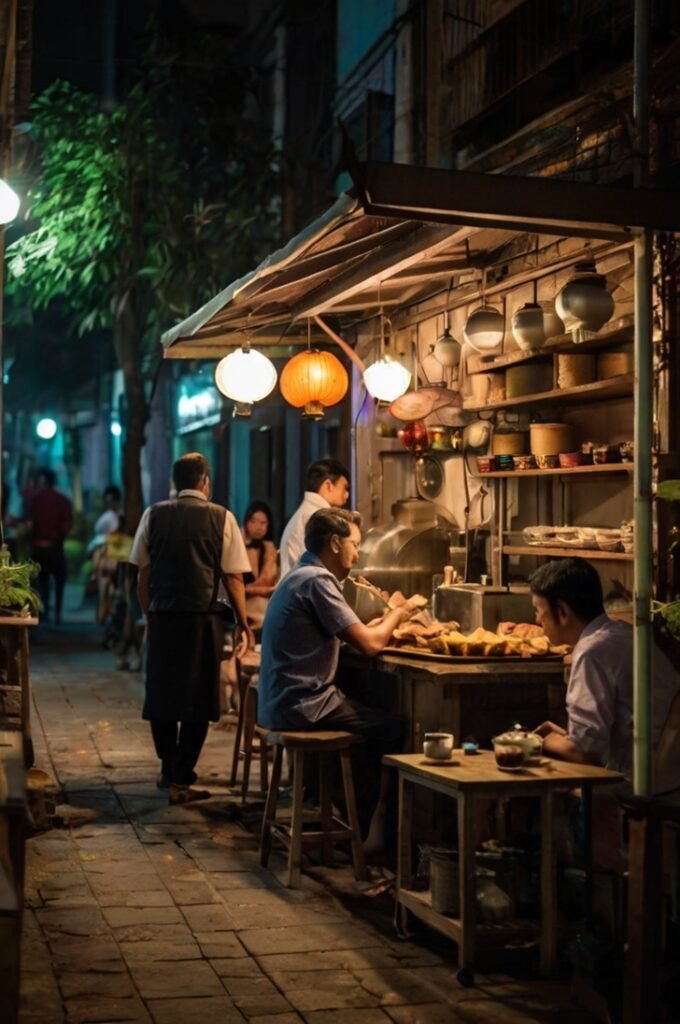

Safety and Comfort during Evening Walks
Evening walks in densely packed residential districts can be an enriching experience, providing an opportunity to unwind and appreciate the local environment. However, ensuring safety should always be a top priority. One of the key considerations is the adequacy of lighting in streets and pathways. Well-lit walkways not only enhance visibility but also deter potential hazards. During your evening stroll, choose routes that feature sufficient streetlights, as adequate illumination significantly contributes to a sense of security.
In addition to ensuring proper lighting, the condition of the walkways plays a crucial role in maintaining safety. Uneven surfaces, potholes, or broken sidewalks can lead to accidents, particularly in low-light situations. Before embarking on your walk, familiarize yourself with the condition of these pathways in your neighborhood. When possible, opt for maintained paths that are free of obstacles, thereby enhancing both safety and comfort.




Another essential aspect is awareness of surroundings. While enjoying the evening ambiance, it is vital to remain alert to your environment. This includes keeping an eye on passing vehicles, particularly in areas with high traffic, and being attentive to other pedestrians or cyclists who may be sharing the space. Maintaining a steady awareness allows for quicker identification of any unexpected scenarios, ensuring a safer walking experience.
Familiar routes in one’s own neighborhood can significantly boost comfort during these evening strolls. Knowing the area well allows walkers to anticipate turns and obstacles while cultivating a sense of belonging to the community. Over time, this familiarity can transform the evening walk into a ritual that evokes relaxation and enjoyment. Thus, prioritizing safety measures does not detract from the experience but rather enhances it, allowing for serene evening strolls through the heart of densely packed residential districts.
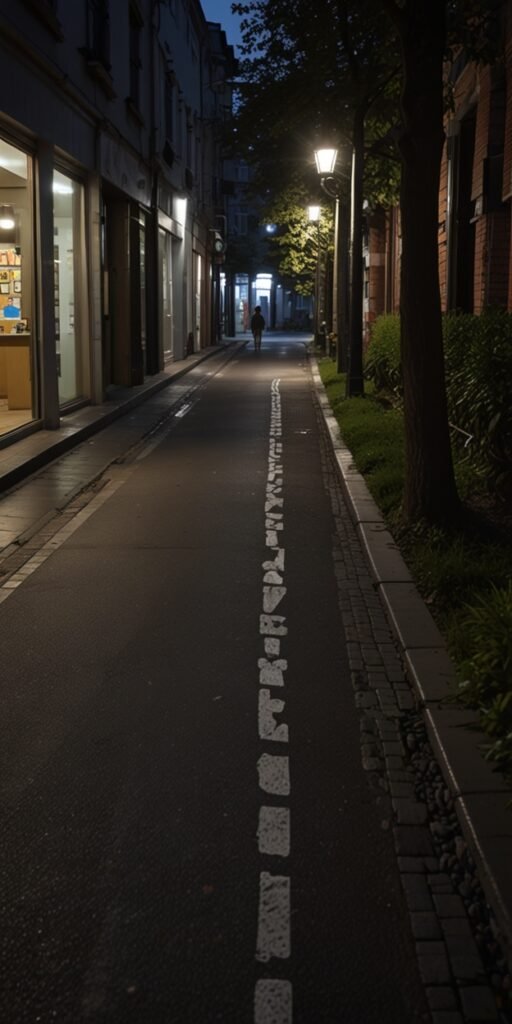

Conclusion: The Enriching Experience of Evening Walks
As we reflect on the significant aspects of evening walks through tightly woven residential districts, it becomes clear that this simple activity offers myriad benefits for both mind and body. Initially, the act of walking in these neighborhoods allows individuals to slow down, enabling them to appreciate the intricate tapestry of daily life unfolding around them. The sounds, sights, and smells of the community come alive in the evening light, creating a refreshing atmosphere that often contrasts sharply with the hustle and bustle of daytime living.
Moreover, evening walks serve as an excellent opportunity to foster a connection with one’s surroundings. Many neighborhoods feature unique architectural styles, lush gardens, and local art that embody the cultural essence of the area. This blend of creativity and community invites walkers to immerse themselves in the local lifestyle, promoting a sense of belonging and appreciation for the intricate details that otherwise may go unnoticed during a hurried commute.

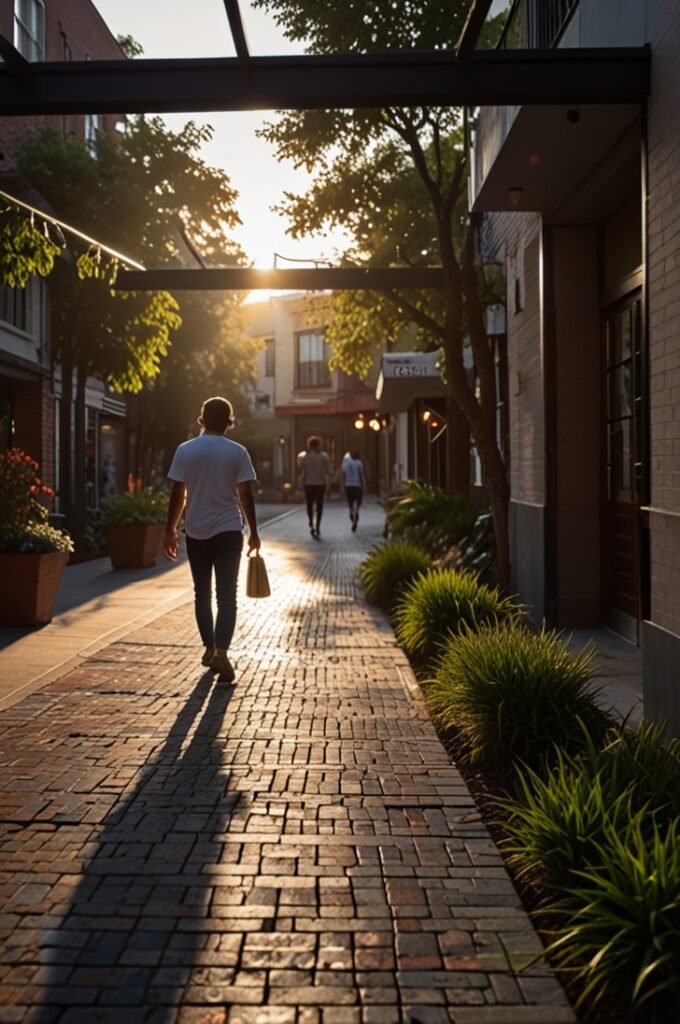
Additionally, the act of walking promotes not only physical health but also mental well-being. Engaging in a leisurely stroll provides individuals a moment of tranquility—a quiet time to reflect, ponder, or simply enjoy the present moment. The health benefits of regular walking are well-documented, and when combined with the enriching experiences derived from exploring residential districts, it becomes a truly holistic endeavor for self-care.
In light of the values posed through evening walks, it is evident that this practice invites a deeper understanding of one’s community and encourages a healthier lifestyle. Embracing evening strolls can enrich your day-to-day experience, enabling you to connect with your environment and nurture a profound appreciation for the beauty and vibrancy nestled within these neighborhoods. Thus, consider adopting this simple yet fulfilling activity as a regular part of your routine; it opens the doors to a world full of wonder and insight.

